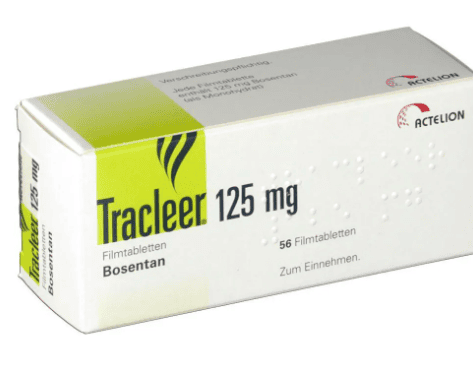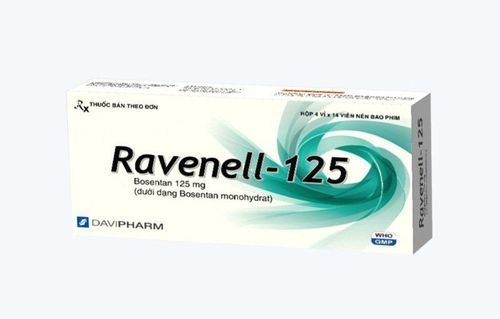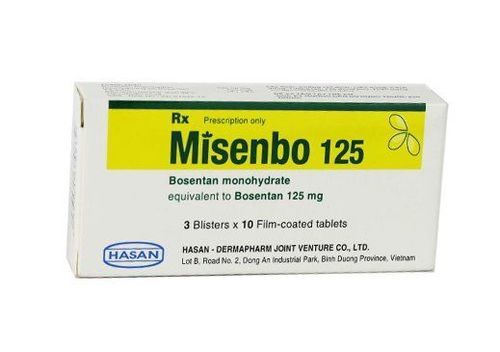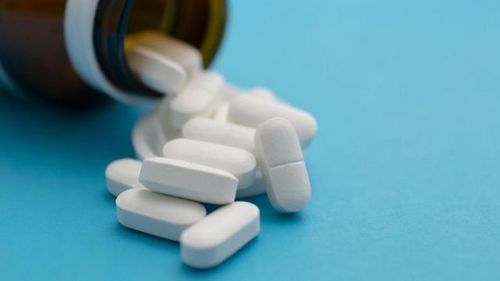This is an automatically translated article.
Safebo belongs to the group of cardiovascular drugs, made in the form of film-coated tablets, packing box of 1 blister x 10 tablets. The main ingredient in Safebo is the active ingredient Bosentan (as Bosentan monohydrate) 62.5mg. Safebo is a prescription drug, and patients are absolutely not allowed to use it without a doctor's prescription and prescription.
1. Indications to use Safebo
Safebo drug is indicated in the treatment of pulmonary arterial hypertension (World Health Organization group I) in symptomatic patients of group III or IV World Health Organization, while helping to improve the ability to practice and reduce the rate of clinical bad cases.
2. Dosage and how to use Safebo
Safebo reference dose is as follows:
Patients over 12 years old: Start treatment with Safebo 62.5 mg x 2 times/day. People with body weight < 40kg): The starting and maintenance dose of Safebo is 62.5mg x 2 times/day. Recommended Safebo dose for children from 1 month to 12 years old: Body weight 10 - 20kg: Start with Safebo 31.25mg/time/day, increase after 4 weeks to maintenance dose 31.25mg x 2 times/day. Body weight 20 - 40 kg: Starting dose 31.25mg x 2 times/day, after 4 weeks increase to maintenance dose 62.5mg x 2 times/day. Body weight over 40kg: Initially 62.5mg x 2 times / day, after 4 weeks maintain the dose of Safebo 125 mg x 2 times / day. Patients with renal impairment: No dose adjustment is required. Dosage:
Take Safebo tablets in the morning and afternoon, with or without food. Note: The above dose of Safebo is for reference only. The specific Safebo dose will depend on your condition and disease progression. To get the right dose of Safebo, patients need to consult their doctor/pharmacist.
3. Contraindications to using Safebo
Safebo is contraindicated in the following cases:
People who are sensitive to Bosentan active ingredients or any of its ingredients; Pregnant; Concomitant use of Safebo with Cyclosporin A is contraindicated as a marked increase in plasma concentrations of Bosentan or Glyburic will increase the risk of elevation of liver enzymes. Patients with moderate or severe hepatic impairment, patients with high levels of Aminotransferase (> 3 x ULN)
4. Side effects of Safebo
Reported Safebo drug side effects include:
Headache; Nasopharyngitis; Facial flushing; Edema; Lower blood pressure ; Dizzy; Palpitations ; Digestive disorders; Itching, rash; Tired; Cramp; Anemia; Anaphylaxis ; Angioedema; Increase liver enzymes; Abnormal liver function, cirrhosis and liver failure. If any abnormal symptoms appear due to the use of Safebo, the patient should notify the treating doctor/pharmacist for timely treatment.
5. Drug interactions
Co-administration of a CYP2C9 inhibitor and a strong or moderate CYP3A inhibitor is not recommended with Bosentan. Plasma concentrations of Bosentan increase while concentrations of Cyclosporin decrease, so Bosentan is contraindicated with Cyclosporin A. Caution is advised when co-administering Tacrolimus with Bosentan. Risk of increased hepatic aminotransferases in patients receiving Bosentan with Glyburide. Ketoconazole increases the plasma concentration of Bosentan. Therefore, the potential for increased effects of Bosentan should be considered. Simvastatin and other Statins when co-administered with Bosentan reduce plasma concentrations of Simvastatin and other Statins. Bosentan reduces the plasma concentration of Warfarin when administered concomitantly. Interactions with other drugs such as Digoxin, Nimodipine, Losartan, Sildenafil, Rifampicin, hormonal contraceptives, Lopinavir/ Ritonavir or other Ritonavir-containing HIV regimens. To avoid unwanted interactions when using Safebo, please inform your doctor/pharmacist of all medicines, dietary supplements, vitamins and herbs... you are taking.
6. Notes when using Safebo
Do not initiate treatment with Bosentan if the patient's systolic blood pressure is below 85 mmHg. Bosentan is contraindicated in patients with moderate to severe hepatic impairment. Hepatic aminotransferase levels should be measured prior to initiating treatment with Bosentan, once a month during treatment, and 2 weeks after dose escalation. Monitor hemoglobin levels during treatment with Bosentan. If hemoglobin levels are markedly reduced, further evaluation is needed to determine the cause. Bosentan should not be used in patients with hypotension. The dose should be reduced gradually to avoid the possibility of clinical deterioration. If signs of pulmonary edema occur during treatment with Bosentan, consider associated pulmonary veno-occlusive disease and discontinuation of the drug. Care should be taken when choosing doses for elderly patients, those with impaired liver/renal function, heart disease, or co-morbidities or other drugs being treated. Bosentan should not be used by pregnant women or women of childbearing potential who are not using a reliable method of contraception. Above is information about uses, dosage and precautions when using Safebo. Note: Safebo is a prescription drug, so patients should not use it on their own, but need to contact a specialist directly for a suitable prescription to ensure safety for health.













